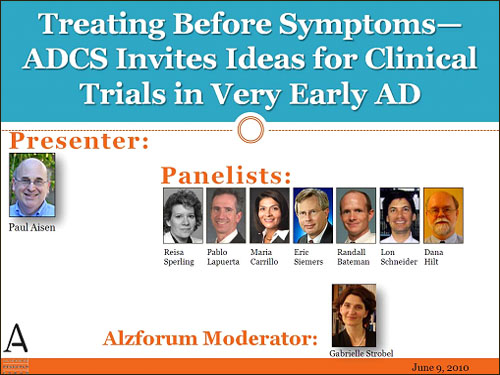Past Webinar
Treating Before Symptoms—ADCS Invites Ideas for Clinical Trials in Very Early AD
Quick Links
Introduction
In this Webinar, Paul Aisen gave a slide talk followed by a panel discussion with Reisa Sperling and Lon Schneider, clinician-researchers and members of the ADCS Steering Committee; Randall Bateman, clinical core leader of DIAN, who is planning drug trials in asymptomatic eFAD mutation carriers; Maria Carrillo, who directs medical and scientific relations at the Alzheimer’s Association, a funding organization for AD research; Eric Siemers, who oversees Phase 3 trials of experimental AD medications at Eli Lilly; Pablo LaPuerta, who directs a Phase 2 trial of an experimental AD drug in prodromal AD for Bristol-Myers Squibb; and Dana Hilt, who runs Phase 1 and 2 trials at the biotechnology company EnVivo Pharmaceuticals.
Aisen outlined the direction the Alzheimer’s Disease Cooperative Study is taking as it prepares for renewal of its parent grant, to be submitted in late 2011. The consortium has a mandate to conduct important therapeutic trials that otherwise would not happen due to intellectual property, strategic or funding constraints, and to develop new outcome measures and trial designs in the process. For this upcoming grant application, Aisen is inviting creative ideas from the research community. Five to seven concrete study proposals will make it into the application.
To prime the pump, Aisen described a trial the ADCS itself is already considering for this funding cycle. It will capitalize on the results of ADNI and other biomarker studies to push treatment not only into an earlier clinical stage, but even further back into a preclinical stage defined exclusively by biomarkers indicating that the neurobiological disease process is underway. This new direction is complementary to initiatives that are beginning to plan therapeutic trials in populations defined by genetics and age, who also have biomarker evidence of AD but no clinical symptoms (see ARF DIAN story and ARF API story).
Read Aisen’s introductory text below and take away inspiration for innovative trial proposals you might want to contribute for inclusion into the ADCS renewal application.—Gabrielle Strobel.
- View/Listen to the Webinar
Click on this image to launch the recording.
Background
Background Text
By Paul S. Aisen, M.D., UCSD, for the Alzheimer’s Disease Cooperative Study (ADCS)
In recent decades, dramatic strides in elucidating the biochemical and cellular mechanisms underlying Alzheimer disease (AD) have led to general optimism that effective disease-modifying interventions may be within reach. Plausible targets have yielded treatments that have advanced into efficacy trials. But the results of those trials have been painfully disappointing. One pivotal trial after another has failed to demonstrate favorable effects on cognitive and clinical measures; xaliproden, tarenflurbil, tramiprosate, rosiglitazone, and most recently, Dimebon have all failed to achieve their primary endpoints in Phase 3 trials. No new treatment has reached the clinic since approval of the last symptomatic medication, memantine, in 2003.
Undoubtedly, some or all of these candidate interventions failed because of insufficient brain penetration and/or target engagement. But non-pharmacological issues may be stacking the deck against the successful development of disease modifiers.
The diagnosis of AD is based on the presence of the clinical syndrome of dementia. But evidence suggests that the neurobiological features of the disease, including plaque deposition, tangle accumulation, and synaptic loss, begin a decade or more before the onset of dementia. Indeed, the prevalence of amyloid deposition in brain as indicated by amyloid PET scanning or low CSF Aβ42 in non-demented older individuals is 20-40 percent (Jack et al., 2010; see ARF Webinar), indicating a huge population of individuals with a cardinal feature of AD pathology but without dementia. If amyloid dysregulation and other neurobiological abnormalities accumulate many years prior to dementia, it is reasonable to assume that the optimal time to change the disease course by interrupting the driving neurodegenerative processes is long before dementia onset. At the late stage of brain failure represented by dementia, attacking these processes may be minimally effective or even futile. If we think of AD neurodegeneration as a smoldering fire destroying the structural integrity of the brain, we must quench the flame before the damage is irreparable.
Clearly, we should seek the tools necessary to test putative disease modifiers in the pre-dementia population, presumably as early as feasible. We must identify individuals on the AD trajectory prior to significant brain dysfunction. And to indicate treatment effects in these individuals we require outcome measures that are dynamic indicators of disease (and treatment response) when there are little or no cognitive and clinical manifestations. In other words, we need surrogate outcome measures that are reasonably likely to predict long-term, clinically relevant benefits. Progress in the development of biochemical and neuroimaging biomarkers of AD suggests that the necessary tools may be close at hand.
The Alzheimer’s Disease Neuroimaging Initiative (ADNI), building on the groundwork laid by many laboratories, has galvanized the AD biomarker field. Progress toward the standardization of methods of image acquisition, processing and analysis, and specimen collection and biochemical methods has made the use of biomarkers in multicenter investigations manageable. A consensus is forming around the sequence of biomarker signals, the relationships among biomarker changes, the association between biomarkers and clinical manifestations of disease, and the efficiency by which biomarker changes reflect disease progression. In other words, we can now formulate reasonable methods of selecting individuals on the pathway toward AD dementia, but with minimal or no clinical features, and we can efficiently track progression.
Of course, therapeutic trials have already been conducted in the pre-dementia phase. In general, these trials have selected subjects on the basis of the Petersen criteria for amnestic MCI (Petersen et al., 1999; Petersen, 2004), though the memory impairment criterion has varied. The trials have aimed to demonstrate treatment effects of cholinesterase inhibitors, vitamin E, or the anti-inflammatory drug rofecoxib, using the time to dementia as the primary measure of efficacy (Jelic et al., 2006). None of these trials has demonstrated unequivocal treatment effects (though one showed a beneficial effect of donepezil for up to two years). While the drugs tested may have limited or no efficacy, the methodology also proved problematic, potentially obscuring treatment effects; in particular, the annual rate of conversion from MCI to dementia varied from 5 percent to 15 percent, with the result that most of the trials were markedly underpowered.
Analysis of ADNI data provides better trial design options for pre-dementia studies. First, ADNI has confirmed the finding in the earlier ADCS MCI study of vitamin E and donepezil that use of education-adjusted cutoffs on the Logical Memory II paragraph recall test yields a population that will progress to dementia at a rate of at least 15 percent per year (Petersen et al., 2010). Second, ADNI has shown that certain continuous outcome measures, notably the CDR-SB but also (to a lesser extent) the expanded 13-item version of the ADAS-cog, are reasonably efficient in tracking decline in individuals with amnestic MCI. The mean to standard deviation ratio of annual change is 0.50 for the CDR-SB and 0.29 for the ADAS-cog13. As demonstrated by simulation studies, using one or both of these as continuous outcome measures provides substantially greater power to detect treatment effects in comparison to the traditional time-to-dementia analysis. The former approach is now tenable, because regulatory agencies are increasingly open to acceptance of amnestic MCI, when anchored by a biomarker of AD neurobiology, as an early stage of disease, consistent with the research criteria proposed by Dubois and colleagues (Dubois et al., 2007). And indeed, further analysis of ADNI data shows that selecting amnestic MCI subjects using a CSF Aβ cutoff score yields a trial population with more rapid decline on continuous measures, further improving the power to demonstrate treatment effects. The first pre-dementia trial of an anti-amyloid compound using this trial design has been launched by Bristol-Myers Squibb (NCT00890890), with eagerly awaited results.
But amnestic MCI with biomarker criteria may not represent the optimal population for disease-modifying drug trials. Most such individuals progress to dementia within a few years; this represents the latest identifiable stage of pre-dementia AD. If such treatments are most likely to show important clinical effects when initiated at the earliest possible stage of the neurobiology, which precedes dementia by 10-15 years, then less impaired individuals should be sought. The current phase of ADNI (ADNI-GO, funded by a Grand Opportunities award from NIA) is recruiting subjects with milder episodic memory impairment, a group referred to as early MCI, or EMCI, to explore this possibility (Aisen et al., 2010).
The optimal population for trials of anti-amyloid agents or other putative disease modifiers may be in the asymptomatic (or pre-symptomatic) stage, with biomarker evidence of amyloid dysregulation but no clinical evidence of cognitive impairment. Based on CSF analysis of the normal cohort in ADNI, this group represents about one-third of older individuals, an enormous group hypothesized to be on the path to clinical AD. Selection of such individuals for a therapeutic trial could be accomplished by screening individuals over a certain age (perhaps 70 years) with spinal taps and/or amyloid PET imaging.
But how could the benefit of treatment be demonstrated? There are no cognitive deficits or symptoms to follow, and the mean time to dementia or even the onset of well-defined symptoms may be many years. Standard outcomes cannot work in such studies. ADNI and other studies suggest potential biomarker endpoints to replace clinical measures. In particular, MRI volumetric measures and FDG-PET activity show longitudinal decline across the entire spectrum from the asymptomatic stage to dementia (Aisen et al., 2010). A trial of an anti-amyloid or neuroprotective treatment could select normal older individuals with biomarker evidence of amyloid dysregulation, and evaluate the effect of treatment on rate of progression as indicated by neuroimaging measures. Such a trial could evaluate novel sensitive cognitive instruments or patient-reported outcomes, but existing data do not justify any such measure as a primary outcome in this population. Notably, a recent paper demonstrates the utility of amyloid PET imaging in the demonstration of reduction of brain amyloid-binding with chronic therapy of AD dementia with an anti-amyloid antibody (Rinne et al., 2010); however, amyloid PET imaging signal does not correlate well with clinical status, and while impact on this biomarker presumably confirms the desired pharmacodynamic effect, it may or may not be a suitable endpoint for an efficacy trial.
ADNI data demonstrate that the presence of amyloid dysregulation as indicated by a low CSF Aβ42 (which correlates tightly with an abnormal amyloid PET scan [Jagust et al., 2009]) is associated with a substantial increase in hippocampal atrophy rate in all cohorts, including the cognitively normal controls; atrophy rate is 1.5-2 times greater in those with a low CSF Aβ42 (Aisen, 2010). Atrophy of the hippocampus and other brain regions correlates with neurodegeneration (Whitwell et al., 2008). We hypothesize that the difference between atrophy rates in those with and without low CSF Aβ42 represents a measure of amyloid-mediated neurodegeneration. Based on the ADNI data in normal controls, 80 percent power to demonstrate a robust reduction in this presumed measure of AD neurobiology can be achieved with a manageable study size and duration (e.g., 200-300 subjects per group followed for two years).
This trial design presents a feasible method for demonstration of disease modification at the earliest identifiable stage of AD neurobiology: amyloid dysregulation without clinical symptoms. Details of the sample size determination should await further accrual of longitudinal data in ADNI. But one major limitation of this approach is that brain atrophy measures, though they correlate very well with disease progression, have not been validated as surrogate outcome measures for drug development. That is, there is no strong evidence that impact of treatment on atrophy will predict eventual clinical benefit. Indeed, early studies of immunotherapy have yielded inconsistent observations on the impact of treatment on atrophy (Fox et al., 2005; Salloway et al., 2009). But MRI analysis methods have improved, and one may predict that treatment effects of disease modifiers on atrophy may be more readily observed at an early stage of disease. If an anti-amyloid intervention showed a central anti-amyloid effect (by PET imaging) coupled with a slowing of atrophy in relevant brain regions, it would be suggestive of a beneficial effect on the neurobiology.
With uncertainty regarding the acceptability of neuroimaging outcomes as surrogates, pharmaceutical companies will be reluctant to pursue such a study. But this design would be appropriate for an NIH-funded study conducted by the Alzheimer’s Disease Cooperative Study (ADCS). The mandate of the ADCS is to conduct important therapeutic trials in AD that might not otherwise be done; this may include a study of a compound without patent protection, a study of a proprietary compound that is outside the development plan of a company, or a study of a compound from a small company or academic group lacking the means to conduct a trial. The ADCS mission also includes the development of novel outcome measures and trial designs.
The next application for competitive renewal of the ADCS parent grant will be submitted to NIA in late 2011. This application will likely propose five to seven new studies. The ADCS is currently seeking and evaluating project ideas from small companies and academic investigators (for guidelines see ADCS website).
A trial in asymptomatic individuals with an amyloid biomarker signal, using neuroimaging primary outcome measures, is currently under consideration by the group. Comments on this design are welcome. If this project moves forward, an unbiased process for selecting the active treatment would be developed and implemented. The enormous success of ADNI provides strong support for a model of extensive collaboration among academic, industry, government, and nonprofit groups, and such collaboration is highly valued by the ADCS.
References:
Aisen PS, Petersen RC, Donohue MC, Gamst A, Raman R, Thomas RG, Walter S, Trojanowski JQ, Shaw LM, Beckett LA, Jack CR, Jagust W, Toga AW, Saykin AJ, Morris JC, Green RC, Weiner MW, Alzheimer's Disease Neuroimaging Initiative. Clinical Core of the Alzheimer's Disease Neuroimaging Initiative: progress and plans. Alzheimers Dement. 2010 May;6(3):239-46. Abstract
Dubois B, Feldman HH, Jacova C, Dekosky ST, Barberger-Gateau P, Cummings J, Delacourte A, Galasko D, Gauthier S, Jicha G, Meguro K, O'brien J, Pasquier F, Robert P, Rossor M, Salloway S, Stern Y, Visser PJ, Scheltens P. Research criteria for the diagnosis of Alzheimer's disease: revising the NINCDS-ADRDA criteria. Lancet Neurol. 2007 Aug;6(8):734-46. Abstract
Fox NC, Black RS, Gilman S, Rossor MN, Griffith SG, Jenkins L, Koller M, AN1792(QS-21)-201 Study. Effects of Abeta immunization (AN1792) on MRI measures of cerebral volume in Alzheimer disease. Neurology. 2005 May 10;64(9):1563-72. Abstract
Jack CR, Knopman DS, Jagust WJ, Shaw LM, Aisen PS, Weiner MW, Petersen RC, Trojanowski JQ. Hypothetical model of dynamic biomarkers of the Alzheimer's pathological cascade. Lancet Neurol. 2010 Jan;9(1):119-28. Abstract
Jagust WJ, Landau SM, Shaw LM, Trojanowski JQ, Koeppe RA, Reiman EM, Foster NL, Petersen RC, Weiner MW, Price JC, Mathis CA, Alzheimer's Disease Neuroimaging Initiative. Relationships between biomarkers in aging and dementia. Neurology. 2009 Oct 13;73(15):1193-9. Abstract
Jelic V, Kivipelto M, Winblad B. Clinical trials in mild cognitive impairment: lessons for the future. J Neurol Neurosurg Psychiatry. 2006 Apr;77(4):429-38. Abstract
Petersen R, G. M., Thomas R, Thal L (2004). Donepezil and Vitamin E for Mild Cognitive Impairment. 9th International Congress on Alzheimer's Disease.
Petersen RC, Aisen PS, Beckett LA, Donohue MC, Gamst AC, Harvey DJ, Jack CR, Jagust WJ, Shaw LM, Toga AW, Trojanowski JQ, Weiner MW. Alzheimer's Disease Neuroimaging Initiative (ADNI): clinical characterization. Neurology. 2010 Jan 19;74(3):201-9. Abstract
Petersen RC, Smith GE, Waring SC, Ivnik RJ, Tangalos EG, Kokmen E. Mild cognitive impairment: clinical characterization and outcome. Arch Neurol. 1999 Mar;56(3):303-8. Abstract
Rinne JO, Brooks DJ, Rossor MN, Fox NC, Bullock R, Klunk WE, Mathis CA, Blennow K, Barakos J, Okello AA, Rodriguez Martinez de Liano S, Liu E, Koller M, Gregg KM, Schenk D, Black R, Grundman M. 11C-PiB PET assessment of change in fibrillar amyloid-beta load in patients with Alzheimer's disease treated with bapineuzumab: a phase 2, double-blind, placebo-controlled, ascending-dose study. Lancet Neurol. 2010 Apr;9(4):363-72. Abstract
Salloway S, Sperling R, Gilman S, Fox NC, Blennow K, Raskind M, Sabbagh M, Honig LS, Doody R, van Dyck CH, Mulnard R, Barakos J, Gregg KM, Liu E, Lieberburg I, Schenk D, Black R, Grundman M, Bapineuzumab 201 Clinical Trial Investigators. A phase 2 multiple ascending dose trial of bapineuzumab in mild to moderate Alzheimer disease. Neurology. 2009 Dec 15;73(24):2061-70. Abstract
Whitwell JL, Josephs KA, Murray ME, Kantarci K, Przybelski SA, Weigand SD, Vemuri P, Senjem ML, Parisi JE, Knopman DS, Boeve BF, Petersen RC, Dickson DW, Jack CR. MRI correlates of neurofibrillary tangle pathology at autopsy: a voxel-based morphometry study. Neurology. 2008 Sep 2;71(10):743-9. Abstract
References
Webinar Citations
News Citations
- St. Louis: Scientists, Families Target Preclinical Detection, Trials
- Phoenix: Vision of Shared Prevention Trials Lures Pharma to Table
Paper Citations
- Aisen PS, Petersen RC, Donohue MC, Gamst A, Raman R, Thomas RG, Walter S, Trojanowski JQ, Shaw LM, Beckett LA, Jack CR, Jagust W, Toga AW, Saykin AJ, Morris JC, Green RC, Weiner MW, . Clinical Core of the Alzheimer's Disease Neuroimaging Initiative: progress and plans. Alzheimers Dement. 2010 May;6(3):239-46. PubMed.
- Dubois B, Feldman HH, Jacova C, Dekosky ST, Barberger-Gateau P, Cummings J, Delacourte A, Galasko D, Gauthier S, Jicha G, Meguro K, O'brien J, Pasquier F, Robert P, Rossor M, Salloway S, Stern Y, Visser PJ, Scheltens P. Research criteria for the diagnosis of Alzheimer's disease: revising the NINCDS-ADRDA criteria. Lancet Neurol. 2007 Aug;6(8):734-46. PubMed.
- Fox NC, Black RS, Gilman S, Rossor MN, Griffith SG, Jenkins L, Koller M. Effects of Abeta immunization (AN1792) on MRI measures of cerebral volume in Alzheimer disease. Neurology. 2005 May 10;64(9):1563-72. PubMed.
- Jack CR, Knopman DS, Jagust WJ, Shaw LM, Aisen PS, Weiner MW, Petersen RC, Trojanowski JQ. Hypothetical model of dynamic biomarkers of the Alzheimer's pathological cascade. Lancet Neurol. 2010 Jan;9(1):119-28. PubMed.
- Jagust WJ, Landau SM, Shaw LM, Trojanowski JQ, Koeppe RA, Reiman EM, Foster NL, Petersen RC, Weiner MW, Price JC, Mathis CA, . Relationships between biomarkers in aging and dementia. Neurology. 2009 Oct 13;73(15):1193-9. PubMed.
- Jelic V, Kivipelto M, Winblad B. Clinical trials in mild cognitive impairment: lessons for the future. J Neurol Neurosurg Psychiatry. 2006 Apr;77(4):429-38. PubMed.
- Petersen RC, Aisen PS, Beckett LA, Donohue MC, Gamst AC, Harvey DJ, Jack CR, Jagust WJ, Shaw LM, Toga AW, Trojanowski JQ, Weiner MW. Alzheimer's Disease Neuroimaging Initiative (ADNI): clinical characterization. Neurology. 2010 Jan 19;74(3):201-9. PubMed.
- Petersen RC, Smith GE, Waring SC, Ivnik RJ, Tangalos EG, Kokmen E. Mild cognitive impairment: clinical characterization and outcome. Arch Neurol. 1999 Mar;56(3):303-8. PubMed.
- Rinne JO, Brooks DJ, Rossor MN, Fox NC, Bullock R, Klunk WE, Mathis CA, Blennow K, Barakos J, Okello AA, Rodriguez Martinez de Liano S, Liu E, Koller M, Gregg KM, Schenk D, Black R, Grundman M. 11C-PiB PET assessment of change in fibrillar amyloid-beta load in patients with Alzheimer's disease treated with bapineuzumab: a phase 2, double-blind, placebo-controlled, ascending-dose study. Lancet Neurol. 2010 Apr;9(4):363-72. Epub 2010 Feb 26 PubMed.
- Salloway S, Sperling R, Gilman S, Fox NC, Blennow K, Raskind M, Sabbagh M, Honig LS, Doody R, van Dyck CH, Mulnard R, Barakos J, Gregg KM, Liu E, Lieberburg I, Schenk D, Black R, Grundman M, . A phase 2 multiple ascending dose trial of bapineuzumab in mild to moderate Alzheimer disease. Neurology. 2009 Dec 15;73(24):2061-70. PubMed.
- Whitwell JL, Josephs KA, Murray ME, Kantarci K, Przybelski SA, Weigand SD, Vemuri P, Senjem ML, Parisi JE, Knopman DS, Boeve BF, Petersen RC, Dickson DW, Jack CR. MRI correlates of neurofibrillary tangle pathology at autopsy: a voxel-based morphometry study. Neurology. 2008 Sep 2;71(10):743-9. PubMed.
Other Citations
External Citations
Further Reading
Papers
- Lorenzo A, Yuan M, Zhang Z, Paganetti PA, Sturchler-Pierrat C, Staufenbiel M, Mautino J, Vigo FS, Sommer B, Yankner BA. Amyloid beta interacts with the amyloid precursor protein: a potential toxic mechanism in Alzheimer's disease. Nat Neurosci. 2000 May;3(5):460-4. PubMed.
Panelists
-
 Paul Aisen, MD
USC Alzheimer’s Therapeutic Research Institute
Paul Aisen, MD
USC Alzheimer’s Therapeutic Research Institute
-
 Reisa Sperling, M.S.
Center for Alzheimer Research and Treatment, Brigham and Women's Hospital, Massachusetts General Hospital, Harvard Medical School
Reisa Sperling, M.S.
Center for Alzheimer Research and Treatment, Brigham and Women's Hospital, Massachusetts General Hospital, Harvard Medical School
-
 Randall Bateman, M.D.
Washington University School of Medicine
Randall Bateman, M.D.
Washington University School of Medicine
-
 Maria Carrillo, Ph.D.
Alzheimer's Association
Maria Carrillo, Ph.D.
Alzheimer's Association
-
 Eric Siemers, M.D.
Acumen Pharmaceuticals
Eric Siemers, M.D.
Acumen Pharmaceuticals
-
Pablo Lapuerta, M.D. Bristol-Myers Squibb
-
 Lon S. Schneider, M.D., M.S.
University of Southern California Keck School of Medicine
Lon S. Schneider, M.D., M.S.
University of Southern California Keck School of Medicine
-
 Dana Hilt
EnVivo Pharmaceuticals
Dana Hilt
EnVivo Pharmaceuticals


Comments
No Available Comments
Make a Comment
To make a comment you must login or register.